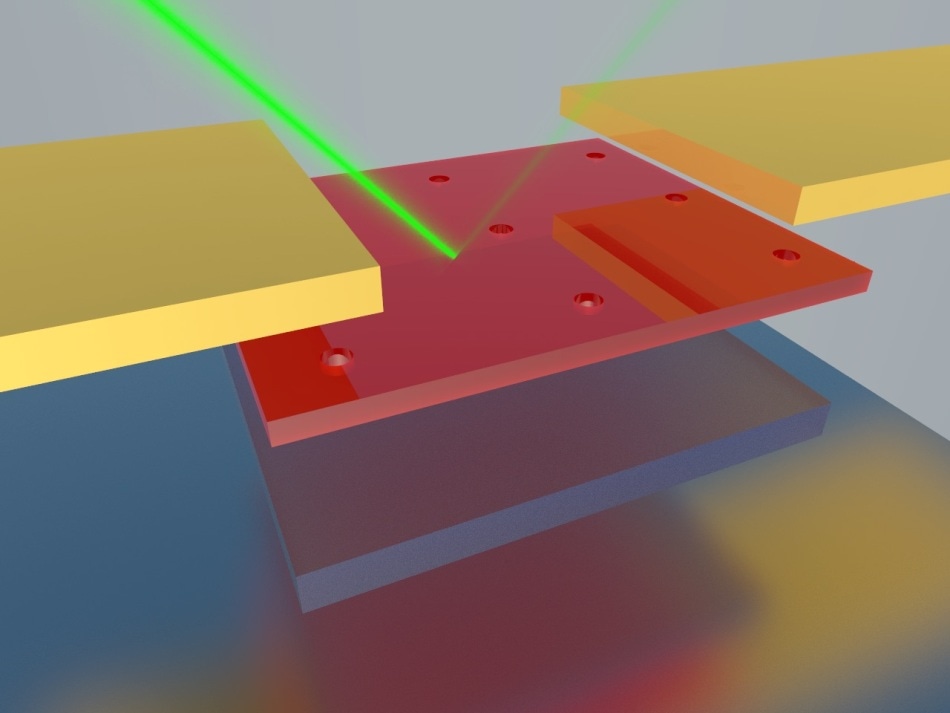Jul 10 2017
In today's increasingly powerful electronics, tiny materials are a must as Manufacturers seek to increase performance without adding bulk.
 Tuned to absorb specific light wavelengths, the new photodetector consists of nanocavities sandwiched between a ultrathin single-crystal germanium top layer and reflective silver on the bottom. Illustration by Zhenyang Xia/UW-Madison College of Engineering
Tuned to absorb specific light wavelengths, the new photodetector consists of nanocavities sandwiched between a ultrathin single-crystal germanium top layer and reflective silver on the bottom. Illustration by Zhenyang Xia/UW-Madison College of Engineering
In the case of optoelectronic devices, smaller is also better. For instance, solar cells or camera sensors which are capable of collecting light and converting it into electrical energy are ideal choices. One can think, for instance, about decreasing the size and weight of a series of solar panels, generating a higher-quality photo in low lighting conditions, or even transmitting data more rapidly.
Nevertheless, there are two major challenges that have to be faced: First of all, the quality is reduced while the size of traditionally used “amorphous” thin-film materials is decreased. Secondly, when ultra thin materials become very thin, they become virtually transparent and actually lose some ability to absorb or gather light.
Currently, a team of Engineers from the University of Wisconsin–Madison and the University at Buffalo have overcome both of those impediments with the help of a nanoscale photo detector that combines a unique fabrication method and light-trapping structures.
The journal “Science Advances”, published on 9th July, features the single-crystalline germanium nano-membrane photo detector on a nano-cavity substrate - the device jointly developed by the Researchers, Electrical Engineering Professors Zongfu Yu and Zhenqiang (Jack) Ma at UW–Madison and Qiaoqiang Gan at UB.
The idea, basically, is you want to use a very thin material to realize the same function of devices in which you need to use a very thick material.
Zhenqiang (Jack) Ma, Electrical Engineering Professor, UW-Madison
The device comprises of nano-cavities tightly packed between a top layer of ultrathin single-crystal germanium and a reflecting silver layer.
“Because of the nano-cavities, the photons are ‘recycled’ so light absorption is substantially increased — even in very thin layers of material,” says Ma.
An orderly series of tiny interconnected molecules that effectively reflect, or circulate light result in nano-cavities. Gan has already demonstrated that his nano-cavity structures increase the amount of light that thin semiconducting materials like germanium can absorb.
A majority of germanium thin films however start as germanium in its amorphous form which indicates that the material’s atomic arrangement is devoid of the regular, repeating order of a crystal. In addition, it also indicates that the quality is insufficient for growing smaller optoelectronics applications.
Ma’s expertise comes into play exactly under these conditions. Ma, a world expert in semiconductor nano-membrane devices, used an innovative membrane-transfer technology that enabled him to easily combine single crystalline semi conducting materials onto a substrate.
As a result, a very thin, yet very effective, light-absorbing photo detector was obtained which will serve as the fundamental unit for the future of optoelectronics.
“It is an enabling technology that allows you to look at a wide variety of optoelectronics that can go to even smaller footprints, smaller sizes,” says Yu, who performed computational analysis of the detectors.
In addition to showing their expertise using a germanium semiconductor, the Researchers can apply their technique to other semiconductors also.
And importantly, by tuning the nano-cavity, we can control what wavelength we actually absorb. This will open the way to develop lots of different optoelectronic devices.
Qiaoqiang Gan, UB
With the help of Wisconsin Alumni Research Foundation, the Researchers are applying jointly for a patent on the technology. Other Authors on the paper include Zhenyang Xia, Munho Kim, Ming Zhou, Tzu-Hsuan Chang, Dong Liu, Xin Yin, Kanglin Xiong, Hongyi Mi and Xudong Wang of UW–Madison; Haomin Song of the University at Buffalo; and Fengnian Xia of Yale University.